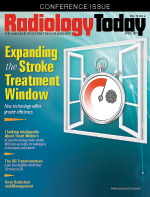 April 2017
April 2017
Editor's Note: Above and Beyond
By Dave Yeager
Radiology Today
Vol. 18 No. 4 P. 4
The drive to do more is central to humanity. Why mess with fire when these raw vegetables are perfectly tasty? Why bother to develop written language when we can just talk things over? Why build an airplane when we weren't born with wings? Without getting into sociological theory, the simple answer to all of those questions seems to be: because somebody foresaw that they would improve our quality of life. One industry that has wholeheartedly adopted this ethos is health care. When was the last time you went more than a day without hearing about exciting research findings or technological advances that offered the potential for better care? In this issue, we take a look at some technological advances that are poised to change how health care is delivered and some that are already making a difference in patients' lives.
For our cover story, Dan Harvey reports on advancements in stroke treatment that are lengthening effective treatment times. Patients who once may have developed severe disabilities can now be treated with fewer side effects. As these interventional methods advance, they offer hope for thousands of people who may not be fortunate enough to quickly receive treatment at the onset of a stroke.
Another technology with the potential to improve patient care relies on deep learning algorithms to automatically segment and measure cardiac MRI images. Manually performing those tasks is time consuming, but the new software provides results in minutes. Beth Orenstein's article examines how the technology was developed, how it's being used, and where it may be used in the future.
There's also a management side to health care. The methods for getting things done are almost as important as the end results. For example, DR offers many efficiencies over CR. As reimbursements for CR continue to dwindle, more facilities are looking for ways to switch to DR. Keith Loria writes about the process of converting from CR to DR and the available options.
Good management can have long-term implications, too, such as managing radiation dose data. Many manufacturers and researchers are looking for ways to reduce the dose that's delivered to patients, but health care organizations need to track that dose for the sake of their patients and, increasingly, to satisfy reporting and reimbursement requirements. We look at some of the solutions and challenges to reducing dose and managing dose data.
Finally, we have a new section editor for our On the Case department: Alex Merkulov, MD, the section head of women's imaging at UCONN Health, steps into the position that has been ably filled by Rahul Pawar, MD, since 2011. Thank you for your contributions, Rahul, and welcome, Alex!
Enjoy the issue.

